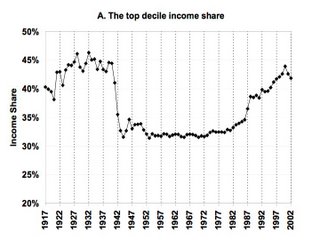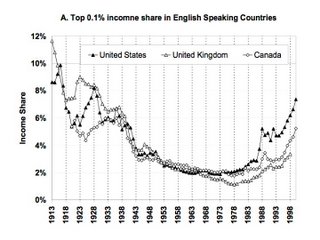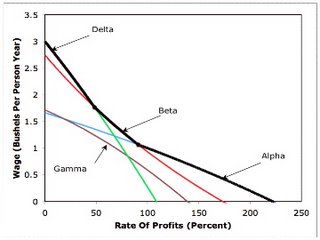IntroductionIn comments on a previous
post, Radek comments on some work of Steve Keen's. Since I've let something like a week go by, I thought I ought to raise this response to a post.
I respond more to people I disagree with. But I think I ought to note that, like DSquared, I respect Solow, while disagreeing with him. My favorite polemic from the Cambridge Capital Controversy is this:
“I have long since abandoned the illusion that participants in this debate actually communicate with each other. So I omit the standard polemical introduction, and get down to business at once.” –- Robert M. Solow (1962)
But back to Keen. What I appreciate most in Keen’s book is his attempt to convey to the introductory student and common reader that good reason exists to doubt (mainstream) economics, no matter how much (mainstream) economists attempt to blind one with “science”. Keen claims very little originality for most of what he has to say. As one can see, I have some disagreements with Keen’s attempts at popularization. But the discussion in this post only concerns two out of fourteen chapters in Keen’s book. And Radek does not even concede any virtues in those chapters.
Also, I can do without accusations that Keen is a “hack”, whether “a pretty skillful hack” or not; a “charlatan”; a liar; “dishonest and embarrassing”; “engages in” “dishonest rhetorical trick[s]”. For me, Guiness stout and Monty Python fall in the same category: things I’m still unsure what I think of. But I’m fairly sure abuse is not an argument.
Profit Not Maximized When Price Equal Marginal RevenueChapter 4, “Size Does Matter”, seems to be the most argued about chapter of
Debunking Economics. It surprised me too.
Atomistic competition, in which one has a continuum of infinitesimal agents, is a standard assumption in economics. Keen and Standish (2006) point out that the assumption of atomistic competition is that one firm does not change its level of production in reaction to another firm's variation in production levels. Keen (2001) points out that Stigler shows that, under atomistic competition, the demand curve for a consumption good faced by the firm has the same slope as the demand curve for the market. I find Keen is not original in noting that atomistic competition is incompatible with the usual textbook U-shaped average cost curves:
"Of course, global increasing returns to scale (or more modestly, situations in which efficient scale is reached at a level of output which is noninfinitesimal relative to the total size of the market) remains a problem. Also, we do not deny the descriptive reality of the latter situation." -- Duffie and Sonnenschein (1989)
Radek ignores all this motivation for Keen’s simulations, and I find it difficult to argue with Keen’s claims. And they wreck havoc on mainstream introductory textbooks in microeconomics.
I have done work with simulations in quite different contexts. In my experience with certain researchers, they wanted to see their analytical arguments confirmed by both simulations, in which they could control the environment to which their arguments are applied, and practical applications. I think Radek should welcome my
simulation. If he looks, he will see that I allow the user to vary the order in which firms make decisions. So I agree with Radek in that I think Keen can be challenged here. I also seem to recall an impression that step size matters to convergence in my simulation. I still think I would need to do further work to substantiate these worries.
The Sonnenschein-Mantel-Debreu ResultsKeen brings up the SMD results in Chapter 2 of
Debunking Economics. Duffie and Sonnenschein (1999) characterize these results as stating that "the class of excess demand functions generated by economies has no structure beyond Walras' law and homogeneity" (p. 574). They point out the implication that "the equilibrium price set may be an essentially arbitrary subset of the set of relative prices" (p. 574).
Radek states, "SMD is not about aggregating individual utilities in the sense that Keen's talking about." I find Keen to only be echoing the professional literature on this point. Think, for example, of Kirman’s (1992) analysis of representative agent models, which are widespread in New Classical Economics. Keen’s point is that Margaret Thatcher was wrong in asserting that “There is no such thing as society”. Would Radek accept Kirman’s claims, which I think are along the same lines:
"The problem seems to be embodied in what is an essential feature of a centuries-long tradition in economics, that of treating individuals as acting independently of each other...
If we look back briefly to the result that underlies the whole problem expressed here it is clear that in the standard framework we have too much freedom in constructing individuals. The basic artifact employed is to find individuals each of whose demand behavior is completely independent of the others... making individual behavior dependent or similar may open the way to obtaining meaningful restrictions...
If we are to progress further we may well be forced to theorise in terms of groups who have collectively coherent behaviour. Thus demand and expenditure functions if they are to be set against reality must be defined at some reasonably high level of aggregation. The idea that we should start at the level of the isolated individual is one which we may well have to abandon. There is no more misleading description in modern economics than the so-called microfoundations of macroeconomics which in fact describe the behaviour of the consumption or production sector by the behaviour of one individual or firm. If we aggregate over several individuals, such a model is unjustified...
It is clear that making assumptions on the distribution of agents' characteristics amounts, in some sense, to making assumptions about the organization of society...
In conclusion, then, it is worth repeating that recent theoretical work has shown how little the Walrasian model has to say about aggregate behavior. Economists therefore should not continue to make strong assertions about this behaviour based on so-called general equilibrium models which are, in reality, no more than special examples with no basis in economic theory as it stands."-- Alan Kirman (1989)
Radek comments:
So how 'huge' are SMD results - the fact that one may have multiple equilibria. Well, here I think there's often a good bit of intellectual dishonesty among critics of GE. On one hand they criticise GE for being 'unrealistic' on the other they wave SMD theorem as proof that GE is 'untenable' (again, whatever that means). But seriously, why should you expect the Real World to have a unique equilibrium? Particularly in the presence of wealth effect, which are the driving force behind SMD theorem, and the whole point of doing GE in the first place? Personally I think the possibility of multiple equilibria is a REALISTIC feature of general equilibrium theory and a point in favor of it rather than against it.
One would be in trouble if the theorem predicted a continuum of equilibria, or that the First Theorem no longer applied but that's not the case. One can still do local comperative statics and all them multiple equilibria are still Pareto efficient.
I find the above confused. Tony Lawson is the scholar to read when it comes to “realism” and Post Keynesianism. I don’t say every Post Keynesian agrees with him. But one who wants to engage Post Keynesian discussions of realism of assumptions must read at least some of Lawson. I don’t know what it means to say “the Real World” has multiple or unique equilibria. I think equilibria are properties of models, not characteristics of actually existing capitalist economies, independently of how they are described.
I don't care for Radek’s sort of abusive attack on people who say they are echoing the experts in a field, especially when the attackers do not cite any examples of who they are talking about. I think a good appreciation of the SMD results might require a historical perspective on what (some) economists were (and still are?) claiming about General Equilibrium and what the experts in the field now claim:
"It follows from the preceding observation that the Walrasian theory and the existence theorems do not tell us how to relate tastes, technology, and the distribution of wealth to a single set of relative values. Rather, they tell us that there is at least one vector (and possibly many more) of relative values compatible with the data of the model. In the absence of uniqueness, the comparative statics of how prices and allocations will change with a change in the parameter values is not a well-defined exercise. The finiteness result alluded to above may be of some help here, but what is really needed is a completion of the Walrasian theory that describes the particular choices that are made from the equilibrium set. Such a completion will almost surely require a theory that deals explicitly with the adjustment to equilibrium. If forces are not in balance, what changes will take place in order to bring them into balance?" -- Duffie and Sonnenschein (1989)
I suggested to Keen, prior to the publication of his book, that the assumptions that all agents have identical and homothetic utility functions are merely sufficient, not necessary, conditions to get well-behaved utility functions. On this logical point, I agree with Radek. But Keen has convinced me with his book and later work that, in practice, (mainstream) economists do widely adopt these assumptions in applied work, with little justification.
References- Duffie, Darrell and Hugo Sonnenschein (1989). "Arrow and General Equilibrium Theory", Journal of Economic Literature, V. 27, N. 2 (June): 565-598.
- Keen, Steve (2001). Debunking Economics: The Naked Emperor of the Social Sciences, Zed Books.
- Keen, Steve and Russell Standish (2006). "Profit Maximization, Industry Structure, and Competition: A Critique of Neoclassical Theory", Physica A
- Kirman, Alan (1989). "The Intrinsic Limits of Modern Economic Theory: The Emperor has No Clothes", Economic Journal, V. 99, N. 395: 126-139.
- Kirman, Alan P. (1992). "Whom or What Does the Representative Individual Represent?" Journal of Economic Perspectives, V. 6, N. 2 (Spring): 117-136.
- Solow, Robert M. (1962). “Substitution and Fixed Proportions in the Theory of Capital”, Review of Economic Studies, V. 29, N. 3 (Jun): 207-218.
(6)
(7)
(8)
(9)
(10)
(11)
(12)
(13)
(14)
(15)
(16)
(17)
(18)
(19)
















